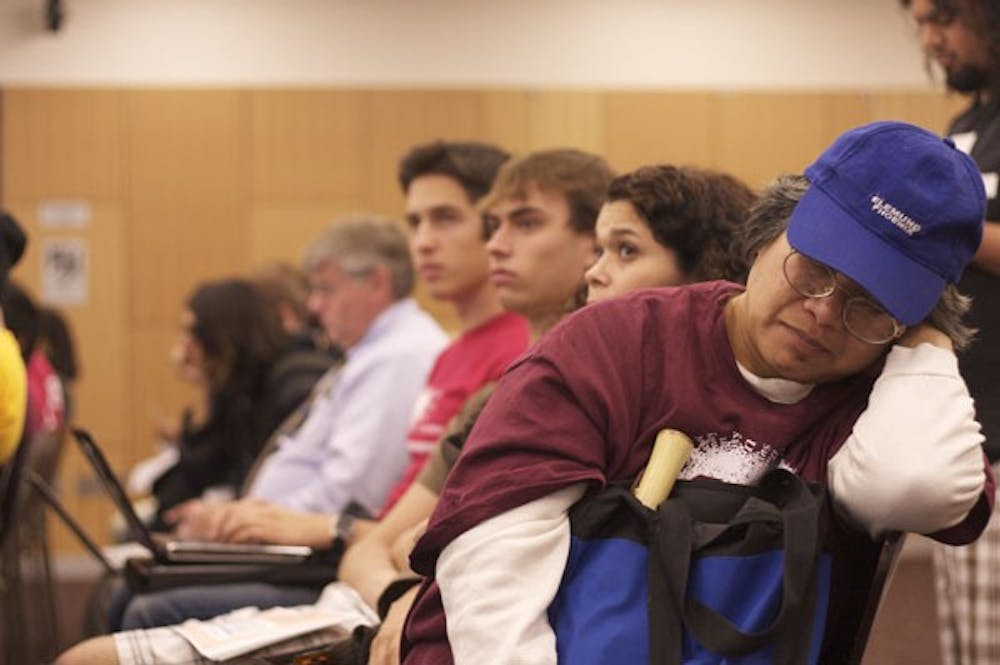Student leaders from ASU, NAU and UA are pointing fingers, and their line of sight is fixed on the state Capitol.
Students and administration officials from the three universities came together Monday evening in an open hearing teleconference held by the Arizona Board of Regents to discuss the universities’ proposed tuition increases.
Student government leaders from each university expressed their frustrations not only over the tuition increases, but also toward the state’s cuts to higher education.
“This time we’re focusing our anger on those who are truly responsible,” said Undergraduate Student Government President Brendan O’Kelly. “And that is the Arizona state Legislature.”
ASU has seen programs cut, faculty members laid off and an increase in class size, O’Kelly said. State budget cuts have forced the University to implement a tuition surcharge, which could double next school year from $510 per year for in-state students to $1,025, he said.
Next year’s proposed surcharge was originally set to increase only to $750, but the amount changed after the University learned that stimulus funds available to the state’s three universities would be $30 million less than originally planned. The extra money is meant to help close the gap.
“The state cannot continue to pawn its constitutionally mandated responsibility to fund our public universities off on students who are scraping the bottom of their bank accounts just to get by,” O’Kelly said.
Andrew Clark, president of the ASU West campus student government, said he does not want to see student leaders having to face the same financial situation next year.
“Our services have dwindled, our ability to have access to classrooms has gone away, and yet our tuition continues to rise,” Clark said of the West campus. “This is not acceptable.”
However, Clark said, student leaders will accept the fact that tuition and fees must go up.
“But that doesn’t mean we have to like it,” he said. “It doesn’t mean it’s right.”
ASU’s in-state tuition will increase by 5 percent for continuing undergraduates under the current proposal, while out-of-state tuition will go up by 3.5 percent. Tuition for incoming undergraduate residents will increase by 12.9 percent.
The tuition increase proposal stays in line with a 2007 proposal that called for a 5 percent per year increase of resident undergraduate tuition.
ASU President Michael Crow said the University has already eliminated six colleges, merged 22 academic departments and laid off 1,281 employees because of its decrease in funding.
But Crow stressed that the University will remain committed to excellence and access.
“Our commitment to access is the following: No student will be left out of attending the University for financial reasons — period,” Crow said.
Journalism sophomore Sabrina Willard, who said she has been forced to obtain $15,000 in student loans, went before regents and said she was an average student stuck between qualifying for financial aid and merit scholarships.
“I don’t want to take out any more loans, and if this increase happens, I might be forced to,” Willard said.
Students at NAU and UA are also feeling the financial impact of tuition increases.
This year’s tuition increase is the highest dollar inflation in the history of UA’s existence, said UA student body president Chris Nagata.
According to a UA press release, the university’s proposal calls for an increase of $1,450 for Arizona resident undergraduates, to $7,224, and to $8,014 for graduate students.
“These increases are supposed to be more palatable due to financial aid, but tell that to the student who works two jobs, who’s increasing their debt and who may be finding another option to further their education,” Nagata said.
Incoming resident freshmen to NAU will be looking at a 15.7 percent increase in tuition and fees, to $7,667. Current in-state student tuition and fees will go up by $167 for sophomores ($6,794), juniors ($5,848) and seniors ($7,053).
Reach the reporter at kjdaly@asu.edu





